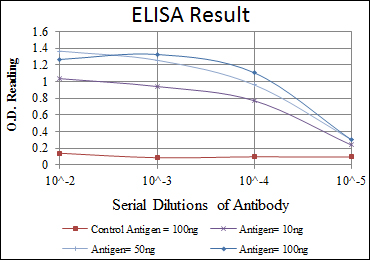HSP90β Monoclonal Antibody
- Catalog No.:YM0342
- Applications:WB;IHC;IF;FCM;ELISA
- Reactivity:Human;Mouse;Rat;Monkey
- Target:
- HSP90B
- Fields:
- >>Protein processing in endoplasmic reticulum;>>PI3K-Akt signaling pathway;>>Necroptosis;>>Antigen processing and presentation;>>NOD-like receptor signaling pathway;>>IL-17 signaling pathway;>>Th17 cell differentiation;>>Progesterone-mediated oocyte maturation;>>Estrogen signaling pathway;>>Salmonella infection;>>Pathways in cancer;>>Chemical carcinogenesis - receptor activation;>>Prostate cancer;>>Lipid and atherosclerosis;>>Fluid shear stress and atherosclerosis
- Gene Name:
- HSP90AB1
- Protein Name:
- Heat shock protein HSP 90-beta
- Human Gene Id:
- 3326
- Human Swiss Prot No:
- P08238
- Mouse Gene Id:
- 15516
- Mouse Swiss Prot No:
- P11499
- Rat Gene Id:
- 301252
- Rat Swiss Prot No:
- P34058
- Immunogen:
- Purified recombinant fragment of human HSP90β expressed in E. Coli.
- Specificity:
- HSP90β Monoclonal Antibody detects endogenous levels of HSP90β protein.
- Formulation:
- Liquid in PBS containing 50% glycerol, 0.5% BSA and 0.02% sodium azide.
- Source:
- Monoclonal, Mouse
- Dilution:
- WB 1:500 - 1:2000. IHC 1:200 - 1:1000. IF 1:200 - 1:1000. Flow cytometry: 1:200 - 1:400. ELISA: 1:10000. Not yet tested in other applications.
- Purification:
- Affinity purification
- Storage Stability:
- -15°C to -25°C/1 year(Do not lower than -25°C)
- Other Name:
- HSP90AB1;HSP90B;HSPC2;HSPCB;Heat shock protein HSP 90-beta;HSP 90;Heat shock 84 kDa;HSP 84;HSP84
- Molecular Weight(Da):
- 83kD
- References:
- 1. J Biol Chem. 2009 Dec 18;284(51):35381-9.
2. Int J Biol Macromol. 2009 Oct 1;45(3):310-4.
- Background:
- This gene encodes a member of the heat shock protein 90 family; these proteins are involved in signal transduction, protein folding and degradation and morphological evolution. This gene encodes the constitutive form of the cytosolic 90 kDa heat-shock protein and is thought to play a role in gastric apoptosis and inflammation. Alternative splicing results in multiple transcript variants. Pseudogenes have been identified on multiple chromosomes. [provided by RefSeq, Dec 2012],
- Function:
- function:Molecular chaperone. Has ATPase activity.,PTM:Phosphorylated upon DNA damage, probably by ATM or ATR.,similarity:Belongs to the heat shock protein 90 family.,subcellular location:Identified by mass spectrometry in melanosome fractions from stage I to stage IV.,subunit:Homodimer. Interacts with TP53/p53 (By similarity). Interacts with UNC45A. Binding to UNC45A involves 2 UNC45A monomers per HSP90AB1 dimer.,
- Subcellular Location:
- Cytoplasm . Melanosome . Nucleus . Secreted . Cell membrane . Dynein axonemal particle . Cell surface . Identified by mass spectrometry in melanosome fractions from stage I to stage IV (PubMed:17081065). Translocates with BIRC2 from the nucleus to the cytoplasm during differentiation (PubMed:18239673). Secreted when associated with TGFB1 processed form (LAP) (PubMed:20599762). .
- Expression:
- Amygdala,Brain cortex,Colon,Colon carcinoma,Embryon
- June 19-2018
- WESTERN IMMUNOBLOTTING PROTOCOL
- June 19-2018
- IMMUNOHISTOCHEMISTRY-PARAFFIN PROTOCOL
- June 19-2018
- IMMUNOFLUORESCENCE PROTOCOL
- September 08-2020
- FLOW-CYTOMEYRT-PROTOCOL
- May 20-2022
- Cell-Based ELISA│解您多样本WB检测之困扰
- July 13-2018
- CELL-BASED-ELISA-PROTOCOL-FOR-ACETYL-PROTEIN
- July 13-2018
- CELL-BASED-ELISA-PROTOCOL-FOR-PHOSPHO-PROTEIN
- July 13-2018
- Antibody-FAQs
- Products Images
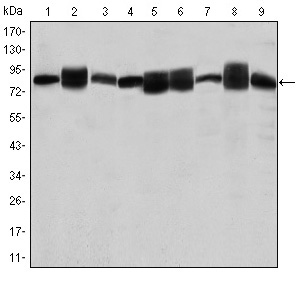
- Western Blot analysis using HSP90β Monoclonal Antibody against Jurkat (1), A431 (2), HeLa (3), A549 (4), HEK293 (5), K562 (6), NIH/3T3 (7), PC-12 (8) and Cos7 (9) cell lysate.
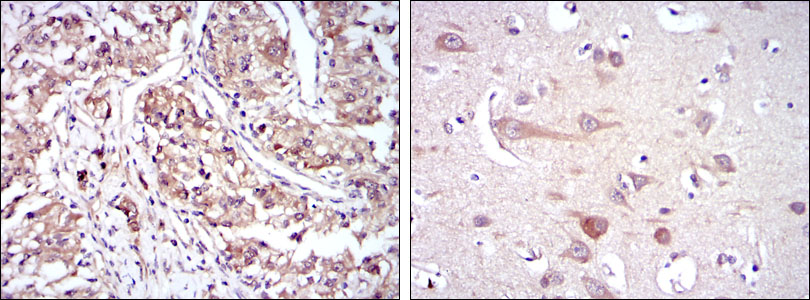
- Immunohistochemistry analysis of paraffin-embedded kidney cancer tissues (left) and brain tissues (right) with DAB staining using HSP90β Monoclonal Antibody.
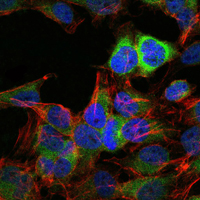
- Immunofluorescence analysis of Hela cells using HSP90β Monoclonal Antibody (green). Blue: DRAQ5 fluorescent DNA dye. Red: Actin filaments have been labeled with Alexa Fluor-555 phalloidin.
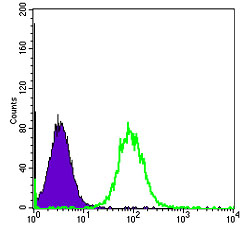
- Flow cytometric analysis of Hela cells using HSP90β Monoclonal Antibody (green) and negative control (purple).
